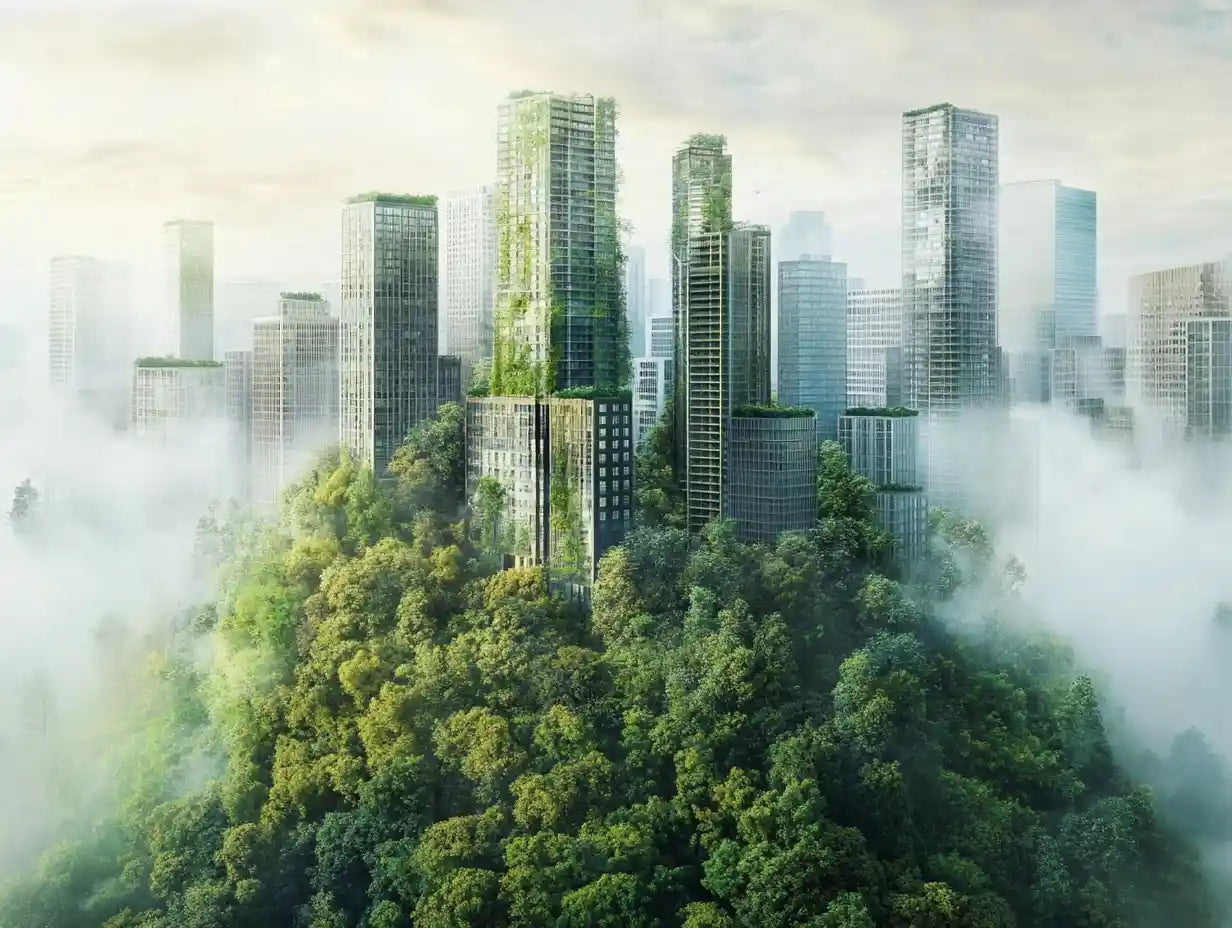
Building sustainable cities has become one of the most pressing challenges of our time. As urban populations grow and environmental concerns intensify, we need innovative solutions to create spaces that are both livable and eco-friendly. That’s where artificial intelligence (AI) steps in, offering transformative tools to rethink how we design ecological cities.
By merging AI with urban planning, we’re unlocking smarter ways to optimize energy use, reduce waste, and enhance green spaces. AI doesn’t just help us analyze data—it empowers us to predict and adapt to future challenges, ensuring our cities remain resilient. This integration isn’t just about technology; it’s about creating a harmonious balance between modern living and the natural world.

Understanding Ecological Cities
Ecological cities prioritize sustainability, preserving resources while enhancing residents' quality of life. They integrate natural systems into urban design, promoting biodiversity, clean air, and renewable energy usage. By addressing pollution and resource scarcity, these cities aim to create harmony between human development and the environment.
Key features of ecological cities include energy-efficient infrastructure, waste reduction systems, and optimized transportation networks. Examples include green roofs to reduce heat, smart waste management to decrease landfill reliance, and public transit systems to minimize emissions. These elements align with decarbonization goals and improve urban livability.
Urban planning in ecological cities emphasizes adaptive and forward-thinking approaches. Instead of separate developments, land-use planning combines residential, commercial, and green spaces to ensure balance. By focusing on long-term sustainability, these cities prepare for environmental, population, and resource-related challenges efficiently.
Role Of AI In Urban Planning
AI enables precise decision-making in urban development processes by leveraging data-driven insights. It supports the creation of ecological cities by improving efficiency and sustainability across multiple domains.
Optimizing Resource Allocation
AI processes large datasets to identify patterns in resource usage, such as energy, water, and transportation. By monitoring consumption patterns, AI reduces waste and ensures equitable distribution. For example, AI-powered systems can predict peak energy demands, enabling grid optimization and reducing energy inefficiencies. AI also improves water resource management by analyzing rainfall patterns and consumption rates, ensuring better conservation methods.
AI-driven predictive models help urban planners simulate environmental impacts before implementing projects. This reduces the likelihood of overuse or misallocation of city resources in new developments.
Enhancing Sustainable Architecture
AI aids in designing energy-efficient buildings by analyzing environmental variables like solar exposure, wind dynamics, and temperature fluctuations. This allows us to integrate passive designs, such as ventilation systems or building orientation, tailored for specific climates. AI tools also evaluate materials' sustainability by selecting cost-effective, durable, and eco-friendly options.
Incorporating AI in architecture supports modular construction by optimizing layouts and space usage. This ensures compatibility with renewable energy systems like solar panels and vertical gardens, further enhancing ecological city design goals.

Benefits Of Integrating AI In The Design Of Ecological City
Integrating AI in ecological city designs offers measurable advantages in sustainability and quality of life. It enables data-driven urban planning, ensuring efficient resource use and enhancing environmental resilience.
Improved Energy Efficiency
AI optimizes energy systems by analyzing consumption patterns and predicting peak demand accurately. For instance, it adjusts energy distribution in real-time, ensuring renewable sources are prioritized while reducing reliance on non-renewable energy. Smart grid systems, supported by AI, minimize energy wastage by detecting inefficiencies and redirecting excess energy to where it's needed most.
Smarter Waste Management Systems
AI-powered waste management systems classify, sort, and process waste more effectively. By using machine learning algorithms, these systems identify recycling opportunities, reducing landfill contributions. For example, AI can predict waste generation trends, enabling cities to allocate resources efficiently and ensure timely collection, promoting cleaner urban environments.
Traffic Flow Optimization
AI improves traffic flow through adaptive signal control, autonomous vehicle guidance systems, and predictive traffic analysis. Algorithms process real-time data from sensors and cameras, reducing congestion and lowering emissions. AI also enables better urban mobility planning by modeling traffic scenarios, ensuring transportation efficiency aligns with ecological objectives.
Enhanced Green Spaces Planning
AI facilitates optimal green space allocation by assessing urban heat islands, land use, and biodiversity levels. Predictive algorithms help urban planners design parks and green zones that address climate challenges, such as heatwave mitigation and flood control. AI also monitors vegetation health, ensuring landscaping efforts contribute to the overall ecosystem.

Challenges And Considerations
Integrating AI into ecological city design requires addressing various challenges to ensure its effectiveness and long-term success. These challenges include ethical concerns and the need to balance costs with benefits.
Ethical Concerns
AI integration raises concerns related to data privacy, algorithmic bias, and transparency. Developing AI systems often involves using large datasets, which may collect sensitive information from residents. Protecting this data and ensuring compliance with privacy regulations are critical. Algorithmic bias is another concern; AI systems might unintentionally perpetuate inequalities if datasets lack diversity or contain historical inequities. We must prioritize creating unbiased algorithms to ensure equitable outcomes in city planning. Additionally, the decision-making processes of AI systems need to be transparent to build trust and avoid public resistance.
Balancing Costs And Benefits
AI implementation can involve high upfront costs for technology acquisition, infrastructure updates, and workforce training. While these investments can lead to long-term sustainability and efficiency gains, funding constraints might limit opportunities for some regions. We must carefully evaluate projected benefits, such as reduced resource waste and improved quality of life, against initial expenditures. Collaborative funding models involving governments, private investors, and public stakeholders can mitigate financial challenges. Establishing scalable solutions can also help balance current costs with future benefits, ensuring AI integration is both practical and impactful.

Future Prospects Of AI In Ecological City Design
AI offers transformative opportunities for advancing ecological city design, focusing on sustainability and resilience. Future developments in AI promise to enhance city adaptability through predictive modeling and real-time analytics, particularly in areas like resource management and environmental monitoring.
- AI-Driven Climate Adaptation: Adaptive urban strategies can use AI to predict climate trends and mitigate risks like flooding or extreme heat. For example, AI-powered simulations could guide the integration of natural barriers or implement heat-resistant materials in infrastructure.
- Self-Sustaining Infrastructure: AI could enable systems that continuously adapt and optimize urban resources. Smart grids may balance renewable energy allocation, ensuring efficiency under varying consumption demands. For instance, automated water systems could adjust based on seasonal changes to minimize wastage.
- Dynamic Mobility Solutions: Autonomous transport, supported by AI, may offer greener alternatives like electric vehicle (EV) optimization and smarter public transit routes. Machine learning can refine traffic predictions, enabling low-emission zones and reducing congestion.
- Urban Biodiversity and Ecosystem Support: AI might expand its role in preserving biodiversity by mapping urban ecosystems. Technologies could identify declining species and guide biodiversity-focused urban planning.
- Scalable AI Applications: Widespread AI adoption could involve modular frameworks catering to cities of varying sizes. Scalable solutions might help smaller urban centers implement cost-effective, sustainable strategies aligned with larger metropolises.
Future AI implementations in these areas may align ecological city practices with global sustainability goals, addressing environmental and population growth challenges. By fostering continuous innovation, AI can bridge the gap between technological advancements and nature-centric urban living, shaping a sustainable future.
Conclusion
Integrating AI into the design of ecological cities offers transformative benefits, addressing pressing environmental and urbanization challenges. Through data-driven insights, AI enables enhanced energy management, waste reduction, and green space optimization, fostering sustainable living environments. It also facilitates adaptive urban planning by predicting future needs and aligning development with sustainability goals.
Despite the potential of AI, challenges including ethical considerations and financial investments require careful planning. Transparent systems, collaborations, and scalable solutions play a key role in overcoming these obstacles, ensuring sustainable and equitable urban development.
AI's evolving capabilities promise continuous innovation in ecological city design, strengthening adaptability and resilience. By leveraging advanced technologies, we can align urban growth with environmental conservation, driving progress toward global sustainability objectives.


Comments (0)
Back to Architecture and Design Blog